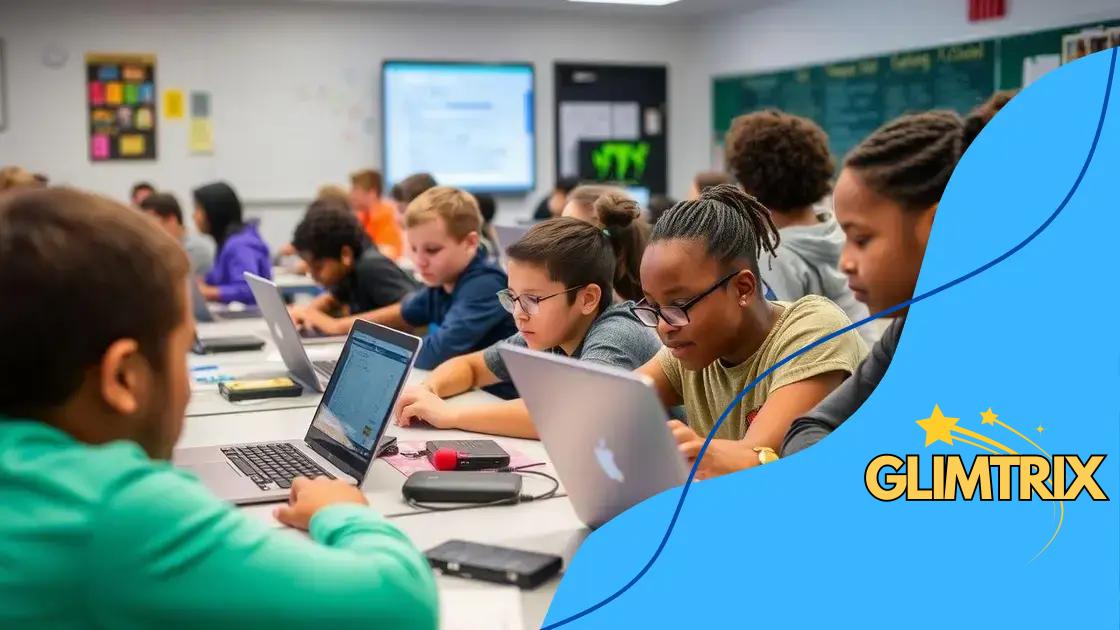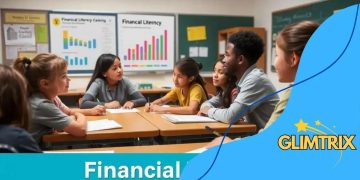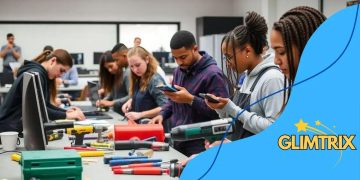Coding as a core subject in schools: Why it matters

Coding as a core subject in schools develops critical thinking, enhances problem-solving skills, and prepares students for future careers by integrating technology into traditional curricula.
Coding as a core subject in schools is quickly becoming essential for preparing students for the digital age. Have you considered how these skills might impact their future careers?
The importance of coding skills for future careers
In today’s world, coding skills are becoming essential for many careers. Understanding code can open doors to opportunities that didn’t exist before. Let’s explore why coding skills matter so much for the future.
Career Opportunities in Tech
Many jobs require some level of coding proficiency. Fields like software development, data analysis, and even digital marketing value these skills highly. Knowing how to code gives students a competitive edge in the job market.
- Software development roles are on the rise.
- Data analysis relies heavily on programming.
- Digital marketing uses coding for analytics and automation.
Even roles outside of technology benefit from coding knowledge. For example, business analysts often work with data, which requires some understanding of coding. This trend indicates that future job seekers should have at least a basic grasp of how to code.
Problem-Solving Skills
Coding is not just about writing lines of code. It’s a way to develop problem-solving skills. When students learn to code, they learn how to break down complex tasks into manageable parts. This skill can be applied in many different careers, not just in tech.
For instance, a student who can tackle a coding project is also likely to be able to approach challenges in other subjects with the same logical mindset. They learn to think critically and analyze problems from various angles.
Preparing for the Future
As technology continues to advance, more industries are integrating coding into their processes. This evolution ensures that students with coding skills will be in demand. Companies need employees who can navigate technological tools and understand how various systems work together.
Ultimately, equipping students with coding skills prepares them for the challenges of the future. By investing in these skills, schools can foster a generation of thinkers and innovators.
How coding fosters critical thinking and problem-solving
Coding is more than just typing lines of code; it is a powerful tool for enhancing critical thinking and problem-solving skills. When students learn to code, they engage in a process that requires careful thought and creative solutions.
Logical Reasoning
At its core, coding teaches students to think logically. When creating a program, they must break down their ideas into smaller, manageable parts. This process improves their ability to analyze problems systematically, helping them approach challenges in a structured way.
- Identifying patterns and logic.
- Breaking problems into smaller steps.
- Testing and refining solutions.
This logical reasoning can be applied beyond coding itself. Students who learn to code tend to approach other subjects—like math and science—with a new perspective. They recognize that many problems require step-by-step solutions.
Creativity and Innovation
Another significant benefit of learning coding is the boost it gives to creativity. Students can create projects that reflect their interests and passions. This freedom encourages them to experiment and innovate.
As students build their own programs or applications, they also learn to overcome obstacles. Encountering and solving bugs—errors in the code—teaches resilience. Instead of giving up, they learn to view problems as opportunities to explore different solutions.
Collaborative Problem-Solving
Coding often involves collaboration. Working with peers on a coding project can enhance problem-solving skills through teamwork. Students discuss ideas, share perspectives, and develop solutions together.
This collaborative spirit is essential in the workplace today. Many future career paths will require teamwork, and coding provides a solid foundation in these skills. Through collaboration on coding projects, students not only learn coding but also how to communicate and function effectively in a team.
Integrating coding into existing curricula

Integrating coding into existing curricula is a transformative step for education. Schools are beginning to understand the value of teaching students how to code alongside traditional subjects.
Enhancing STEM Education
Coding can enhance STEM (Science, Technology, Engineering, and Mathematics) education significantly. By incorporating coding into these subjects, students can see the practical applications of their lessons. For example, in math classes, students might use programming to visualize data sets or solve equations.
- Programming makes abstract concepts more tangible.
- Students develop a deeper understanding of algorithms.
- Hands-on projects can boost engagement and retention.
This approach encourages a more interactive learning environment. Students become active participants in their education, not just passive learners. They can collaborate on projects, share ideas, and build their confidence in both coding and problem-solving.
Cross-Disciplinary Learning
Another important aspect of integrating coding is the ability to promote cross-disciplinary learning. For example, in history class, students can create a timeline application to visualize historical events. In art, they might develop an interactive gallery that showcases their work.
Through these projects, students learn to connect different subjects, making education more cohesive. They see how coding can be useful across various fields. This interdisciplinary approach prepares them for real-world scenarios where collaboration between different domains is common.
Teacher Training and Resources
It’s crucial for teachers to receive proper training and resources to effectively integrate coding into their classrooms. Professional development programs can help educators feel comfortable teaching coding concepts and using technology in creative ways.
Teachers can utilize tools such as online coding platforms and interactive resources to enhance their lessons. By fostering a supportive environment, schools can ensure that both teachers and students have the best tools available to succeed.
Success stories from schools that teach coding
Success stories from schools that teach coding reveal the positive impact on students and their future opportunities. Many schools around the world have implemented coding programs with remarkable results.
Inspired Learning Environments
Schools that integrate coding into their curricula often see an increase in student engagement. One notable example is a school that introduced a project-based learning approach. Students created their own apps, leading to a surge in enthusiasm for not just technology, but also problem-solving.
- Improved collaboration among students.
- Enhanced creativity through app development.
- Increased interest in pursuing STEM careers.
This approach helps students visualize real-world applications of what they learn. Not only do they grasp coding concepts better, but they also develop a sense of accomplishment when completing their projects.
Building Community and Connection
Another success story comes from a school that partnered with local technology companies to enhance their coding curriculum. These partnerships provided students with mentorship opportunities, further connecting them with the tech community.
Students benefited from internships, exposing them to practical work environments. As a result, many students reported feeling more prepared for future careers and eager to explore technology as a viable path.
Measurable Outcomes
Measuring the outcomes of these coding programs shows significant benefits. Schools that implemented coding curricula noted improvements in student performance across subjects. For instance, the correlation between coding and heightened math scores was evident.
Feedback from both teachers and students highlights the advantages of a coding-rich education. More students express interest in math and science, showing that learning to code positively impacts their overall academic journey.
Tools and resources for teaching coding effectively
Teaching coding effectively requires the right tools and resources. With various options available, educators can enhance their lessons and make learning coding fun and engaging.
Interactive Coding Platforms
One popular option is using interactive coding platforms. These websites and programs allow students to learn coding at their own pace. Some platforms provide projects that help students apply what they learn immediately.
- Code.org offers courses for beginners.
- Scratch allows students to create animations and games.
- Khan Academy provides interactive coding activities.
These platforms encourage creativity and give students the freedom to experiment with their work. They also offer teachers valuable progress tracking tools for assessment.
Offline Resources and Tools
In addition to online resources, teachers can use offline tools to enhance their coding lessons. For instance, using robotics kits can help students see the real-world applications of coding.
Kits like LEGO Mindstorms or Ozobots combine coding with hands-on activities, making it exciting and tangible for students. These tools allow students to write code to control robots, deepening their understanding of algorithms and logic through practical engagement.
Professional Development for Educators
Educators also need support to teach coding effectively. Professional development programs can provide teachers with the knowledge they need to feel confident in their coding instruction.
Workshops and courses focusing on the latest teaching methods and technologies can make a big difference. Teachers can learn how to integrate coding into existing subjects, making lessons relevant and connected to students’ interests.
In conclusion, integrating coding into school curricula offers numerous benefits for students. It enhances critical thinking, problem-solving skills, and creativity. With the right tools and resources, teachers can effectively teach coding, inspiring the next generation of innovators. Schools that embrace coding are preparing students not just for careers in technology, but for a future where digital literacy is essential. By fostering a love for coding, we empower students to turn their ideas into reality.
FAQ – Frequently Asked Questions about Coding in Schools
Why is coding important in today’s education?
Coding is essential because it helps students develop critical thinking, problem-solving skills, and creativity, preparing them for future careers.
What resources can teachers use to teach coding effectively?
Teachers can use interactive platforms like Code.org, Scratch, and hands-on tools like robotics kits to enhance coding lessons.
How does coding help with other subjects?
Learning to code encourages logical reasoning and problem-solving, which can improve performance in subjects like math and science.
What are some success stories of coding integration in schools?
Many schools have reported increased student engagement and improved academic performance after integrating coding into their curricula.





